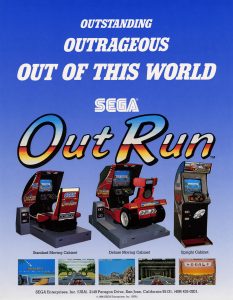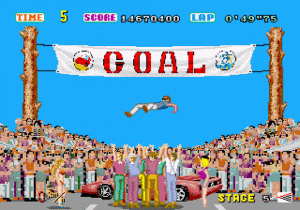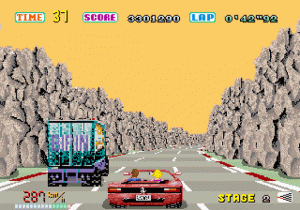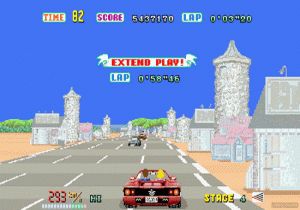 It’s a brisk Saturday afternoon in the fall of 1986. As you step into the arcade, you’re greeted by a familiar neon glow and electronic symphony of beeps, blips, and bleeps. It takes only a moment before, from across the arcade, you spot a new game. A crowd has formed around the cabinet. It’s molded into the form of a bright red sports car. Speakers pump out the screeching of brakes mixed with Latin- and Caribbean-inspired tunes. The entire cabinet shifts and shakes with every jerk of the steering wheel. On the screen, brightly colored pixels fly by at dizzying speeds. The in-game car, vibrant red like the cabinet housing it, weaves dangerously close between other cars in a constant race toward the horizon. Woah! Like the rest of the crowd, you’re mesmerized by this new game. You take a look at the side of the cabinet. Beneath the familiar blue-outlined-in-white SEGA logo, you find the game’s name. Emblazoned in sunset chrome: OutRun.
It’s a brisk Saturday afternoon in the fall of 1986. As you step into the arcade, you’re greeted by a familiar neon glow and electronic symphony of beeps, blips, and bleeps. It takes only a moment before, from across the arcade, you spot a new game. A crowd has formed around the cabinet. It’s molded into the form of a bright red sports car. Speakers pump out the screeching of brakes mixed with Latin- and Caribbean-inspired tunes. The entire cabinet shifts and shakes with every jerk of the steering wheel. On the screen, brightly colored pixels fly by at dizzying speeds. The in-game car, vibrant red like the cabinet housing it, weaves dangerously close between other cars in a constant race toward the horizon. Woah! Like the rest of the crowd, you’re mesmerized by this new game. You take a look at the side of the cabinet. Beneath the familiar blue-outlined-in-white SEGA logo, you find the game’s name. Emblazoned in sunset chrome: OutRun.
Setting a New Pace
Few game series born into the arcades can claim to be as influential and lasting as Sega’s OutRun. It has come to encapsulate a sound, an aesthetic, and an almost indescribable nostalgic vibe. And it all began with one man: Yu Suzuki. He spent decades as a major creative force behind many Sega hits, including other arcade legends like Hang-On and After Burner, and console classics like Shenmue. But his lasting impact on coin-op racers and pop culture truly started with OutRun.
After earlier Sega arcade games like Hang-On and Enduro Racer, Suzuki found himself in search of inspiration for another hit. A two-week tour of Europe and a chance encounter with a Ferrari Testarossa gave him just the inspiration he sought. Suzuki quickly returned to Japan with the beginnings of a new game.
Start Your Engines!
With a deep-seated love of cars and driving, Suzuki knew he wanted to create something different – something that went against the norms of traditional racers. Instead of the typical crash and burn gameplay of circuit racers, he wanted to create a title that relished in the actual act of driving, and create, in his own words, a driving game that simply made players feel “superior” as they cruised across various European-inspired locales. In this game, there would be no laps and no competitors, only an open road and a timer. Suzuki set out to distill the driving down to the purest experience – high speeds, with the top down in a fancy sports car, amid vibrant vistas. Using an innovative sprite scaling technique – dubbed SuperScaler graphics by Sega – and built on a heavily customized Sega System 16 arcade board, Suzuki and his small team of ten completed OutRun in less than a year.
Innovative Design
While the SuperScaler technology was in no way new – not to Sega or to the gaming world – Suzuki pushed the technology to its limit. In order to run the game, a customized board was created and subsequently dubbed the “Sega OuRun” board. This board would be used in future Sega arcade titles, like Super Hang-On. Also, while not the first arcade cabinet to feature hydraulic “body sensation” technology (this honor goes to an earlier Sega title, also by Suzuki, Space Harrier), OutRun popularized this style, so much so that it’s still widely used in modern arcade racing games.
OutRun was released in four main cabinet configurations: two upright and two sit-down. Both upright cabinets consisted of force feedback steering wheels that shake during collisions, a gear shift, and both brake and accelerator pedals. The sit-down cabinets are probably the most well-known versions, with the deluxe version designed to look like the in-game sports car, including illuminated taillights, built-in headrest speakers, and a, then massive, twenty-six-inch CRT screen. Together, these cabinets became Sega’s fastest and best-selling arcade game of the ‘80s, with at least 30,000 units sold. Today, these original cabinets are highly sought after by collectors.
Still Cruising
Based on its massive success in the arcades, OutRun was immediately ported to Amiga, Amstrad, Atari ST, Commodore, and Spectrum computers by game developer U.S. Gold. Of course, OutRun saw ports to Sega’s own Master System and Genesis consoles. These numerous ports came alongside industry accolades, from the 1988 Golden Joystick awards for both “Arcade Game of The Year” and overall “Game of The Year,” to modern nods, such as coming in fourth on IGN’s 2015 list of the most influential racing games of all time.
OutRun has continued to spawn arcade and console sequels, all the way up to a slightly modernized port of the original game released on the Nintendo Switch in early 2019. Its multi-decade longevity is something few other arcade titles, let alone racers, can boast. But what may be most endearing about OutRun is its legacy outside of gaming.
Style, Substance, Memes, and Pop Culture
OutRun’s influence reaches beyond joysticks, gamepads, and arcade cabinets. Its early popularity, success, and unique style has created a pop cultural phenomenon that’s grown into an entirely new, internet-age community. The game’s cool, all-‘80s aesthetic, and ear-catching, original soundtrack consisting of four compositions (all composed in-house by Sega’s Hiroshi Kawaguchi) has had perhaps the most enduring impact. From music genres like Synthwave and New Retro Wave, to album covers, and modern love-letters, a new appreciation for a style lovingly called “OutRun” has made neon-soaked waves within the hearts of nostalgia driven artists, geeks, and gamers. Communities, like the subreddit r/Outrun, to the 2013 debut album of French electronic artist Kavinsky, to movies like Nicolas Winding Refn’s 2011 Drive, all, in ways both large and small, pay some form of homage to Sega’s racing classic.
 Of all the arcade hits of the ‘80s, OutRun has come to embody an ephemeral time and place. Oversaturated chrome sunsets, palm trees, glowing pastels, fast cars, and heavy synthesizers – all inspired by a setting that may only exist in some form of collective consciousness. But now I’m getting a little carried away.
Of all the arcade hits of the ‘80s, OutRun has come to embody an ephemeral time and place. Oversaturated chrome sunsets, palm trees, glowing pastels, fast cars, and heavy synthesizers – all inspired by a setting that may only exist in some form of collective consciousness. But now I’m getting a little carried away.
One thing, though, is certain: no one can deny OutRun’s vitality or the impact it has had on arcades, video games, and the legacy of Sega. Hit racing series like Need for Speed, Burnout, and even Gran Turismo owe some degree of gratitude to Suzuki’s masterpiece. Sega, too, owes much of its success to, if not Out Run itself, at the very least its creator: Yu Suzuki. A video game producer whose many groundbreaking designs helped to keep Sega relevant in the arcades and, to an extent, on consoles.
About the Author: Gene Goodman is vice president of M&P Amusement, a distributor of new and quality refurbished used arcade games and pinball machines in operation since 1932 and headquartered in York, Pennsylvania.



Recent Comments